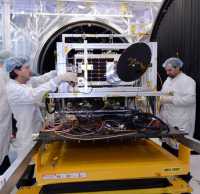 The idea of a Cosmic Rock Space Race might sound like a pretty good concert festival, but in reality it is perhaps a bit telling.
The idea of a Cosmic Rock Space Race might sound like a pretty good concert festival, but in reality it is perhaps a bit telling.
Last week, after a large meteor burned through the atmosphere at some ridiculous speed, exploding in midair, injuring over a thousand, Russian President Vladimir Putin thanked God that no large pieces landed in populous centers, Prime Minister Michael Medvedev joined the call for global defense against Near-Earth Objects, and the opposition leader blamed the explosion on Americans testing a new, secret weapon.
Meanwhile, this week in the United States, some federal agencies are turning their attentions skyward, wondering what can and needs to be done:
One positive action item was actually in place prior to the dual asteroid events of Feb. 15: a new Memorandum of Agreement between the Air, Space, and Cyberspace Operations Directorate of the Air Force Space Command and NASA’s Science Mission Directorate.
That document, which was signed on Jan. 18 of this year, spells out specifics for the public release of meteor data from sources such as high-flying, hush-hush U.S. government space sensors.
The recent Russian meteor event occurred after completion of the newly signed agreement and data on the recent Chelyabinsk event had been released for scientific analysis, SPACE.com has been informed by NASA and the U.S. Air Force.
As a result of that agreement, NASA’s Near Earth Object (NEO) Observation Program is receiving information on bolide/fireball events “based on analysis of data collected by U.S. government sensors.”
Also this week, Canada achieved real progress in the discussion of NEOs with the successful launch of NEOSSat:
The Near-Earth Object Surveillance Satellite (NEOSSat), launched February 25, 2013, is the latest in a proud family of world-leading Canadian satellites. The world’s first space telescope dedicated to detecting and tracking asteroids and satellites. It circles the globe every 100 minutes, scanning space near the Sun to pinpoint asteroids that may someday pass close to Earth. NEOSSat is also sweeping the skies in search of satellites and space debris as part of Canada’s commitment to keeping orbital space safe for everyone. NEOSSat applies the kind of industry-leading technology for which Canada has become known and has already demonstrated in our very successful Microvariability and Oscillations of Stars (MOST) satellite.
The suitcase-sized NEOSSat orbits approximately 800 kilometers high above the Earth, searching for near-Earth asteroids that are difficult to spot using ground-based telescopes. Due to its lofty location, it is not limited by the day-night cycle, and can operate 24/7. The hundreds of images that NEOSSat will generate per day will be downloaded and analyzed by the University of Calgary’s NEOSSat science operations centre. Through NEOSSat, Canada will contribute to the international effort to catalogue the near-Earth population of asteroids producing information that will be crucial to targeting new destinations for future space exploration missions.
Meanwhile, there are developments worth noting in the post-event detective work, Continue reading
